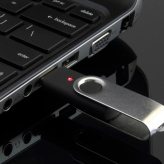 Data breaches are all too common and, without adequate protection, every business is at risk of external attack. In fact, it’s never been more important to ensure your organization’s policies and procedures are foolproof, and that you have contingency plans in place should something go wrong. Google just made that easier for Drive for Work users, by adding physical Security Keys to its safeguarding toolbox. Here’s what you need to know.
Data breaches are all too common and, without adequate protection, every business is at risk of external attack. In fact, it’s never been more important to ensure your organization’s policies and procedures are foolproof, and that you have contingency plans in place should something go wrong. Google just made that easier for Drive for Work users, by adding physical Security Keys to its safeguarding toolbox. Here’s what you need to know.
Google already offers security precautions like two-step authentication, which provides additional protection by requiring you to enter not only your password but also a one-time code received by SMS or similar. This is a crucial weapon in the fight against hackers, since weak usernames and passwords are still be the primary reason for accounts being breached. Security Keys now take things one step further, strengthening your Google Drive account’s coat of armor to an even greater extent.
The Security Key is a physical USB device that is plugged into your computer, and which sends an encrypted signature, instead of a password or other code, to verify your identity and permit you access to your Google account. Crucially, Security Keys are inexpensive – starting from around $6 per unit – and require no additional software for deployment, use or management. Administrators have the ability to track when and where each key is used, as well as being able to disable them if lost and issue backup codes to allow staff uninterrupted access even if they do misplace their key.
Simplifying the login process is also a key part of what Google has tried to achieve with Security Keys. To that end, the first time you use your key to access your Google account on a particular computer, you can opt for Google to remember that device. On subsequent occasions you can quickly sign in using only your password, and without requiring either your key or a two-step authentication code. You can still sign in using your key on other machines, and if a hacker tries to access your account without your key they will also be prompted for a two-step verification code (which, unless they have access to your cell phone, they shouldn’t be able to provide).
Security Keys aren’t an entirely perfect solution, though – there are some significant limitations to the technology. For one, you can’t use them on mobile devices, since they require a USB port to work, and they only allow you to access your Google account through the Chrome browser. Windows, Mac OS, ChromeOS and Linux operating systems are all supported, but if you’re working from your phone or on a browser other than Chrome then you’ll need to continue using two-step authentication. Google says you can mix and match different methods of verification, opting to use Security Keys where they are supported and two-step verification otherwise (or if you don’t have your key with you).
What’s more, only Google Drive currently supports Security Keys – it’s not yet possible to use them with Google Apps, for example. But, while the technology is primarily targeted at Google Drive for Work users, it’s possible to link a single key to multiple accounts, meaning you can use it to access both your work and personal Google accounts. Some users have also queried how much of a safeguard the technology really provides in the absence of an additional PIN code or fingerprint authentication being required for activation, suggesting that a stolen Security Key could be used to access a computer that a user has previously asked Google to remember. But Security Keys do appear to offer at least some additional protection, which will be of comfort to businesses handling sensitive data.
Give us a call to find out how to employ Security Keys and other technology solutions to bolster your protection against network intrusion and data breaches.